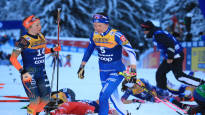The main event of the cross-country skiing season deservedly gathered criticism from many quarters, writes Roope Visuri of Urheilu.
Roope Visuriruheluth reporter
VAL DI FIEMME.
The number one international event of the cross-country skiing season was supposed to be the Tour de Ski this season, but the 18th organized tour was deservedly criticized from different quarters.
1) Miserable despite the intervention
Already in advance, many top-class stars Johannes Hösflot from Kläbo Iivo Niskasen withdrew from the tour due to illness. Of course, nothing can be done for the sick, but at least for the sake of Italy Federico Pellegrino according to the international skiing federation FIS could prevent the risk of getting sick by reducing the number of race weekends.
Then we were amazed at the jury’s decisions. The winner of the opening stage, the free sprint, in Toblach Lucas Chanavat was, along with 11 other male skiers and 2 female skiers, forced out of the tour because they were too slow after the second race.
The jury stretched its rules. It was justified by the fact that right at the beginning and before the tour there had been so many absentees.
Embarrassing situation in the main event of the ski season, that the rules are changed in the middle of everything. Not good.
In the end, even the intervention of the jury did not help. There were an almost historic number of suspensions for women on the tour, even though this is a year without a prestigious competition.
2) Special referee decisions and confusing rules
The jury also got a right to scratch their necks from the pursuit race in Davos. Skied in rough weather, the race would have been better as a joint start race.
Otherwise, the starting order for the competition was confused. It was structured in a complicated way as a subtraction of sprint qualifying and heat phase bonus seconds. In the end, there was also confusion as to how the World Cup points are even distributed from the competition.
The starting order formed by sprint results was not a new thing at the Tour, but it underlined one of the Tour’s big problems.
The rules, with their bonus teams, points competitions and candy marks, are difficult even for the average follower.
There are a lot of average and casual followers at the receivers during the holidays compared to normal World Cup competitions.
In the final ascent of Alpe Cermis, it was the same thing again, a criticized joint start. No one seems to understand why the final climb is contested as a joint start.
The confusion was underlined by the events after Saturday’s women’s co-start race in Val di Fiemme. After the race, FIS offered several different overall situations in its results service. Val di Fiemme’s media space was filled with journalists who wondered about the matter. How can anyone stay on the wagon?
The awards ceremony after the final ascent of Alpe Cermis was also a special sight. Kerttu Niskanen defeated Frida Karlsson, Jonna Sundling and Linn Svahnin in the battle for podium positions in the overall competition.
After that, however, Karlsson had to go to the podium with Diggins, when the top three in the points competition were awarded. Svahn was first and Karlsson third.
It was quite special to see when the severely disappointed athletes had to pick up the small category awards after the main party.
Not good.
3) Competitive route against values
The previous problems are familiar from previous years as well. This season’s Tour had more problems than usual. The competition format was frustrating. The sprints had no bearing on the final results, like Perttu Nice one pointed out.
This year’s race route cannot be said to be very successful either. In practice, the tour was almost back-and-forth, from Toblach in Italy to Davos in Switzerland and back to Val di Fiemme in Italy.
A special solution in the 2020s and from a sports organization that tries, at least in principle, to nurture environmental friendliness in its slogans.
Of course, there is also a logical reason for that, as the traditional ice hockey Spengler Cup was held in Davos before the turn of the year. Even so, the situation was not good for the Tour de Ski and the values it represents.
4) Travel ads failed
The Davos competitions were the best in terms of atmosphere. The evening sprint was amazing to watch. Davos was also the only place where tickets were sold for a good 15 euros at the gate. The ticket lines were also long.
In the big picture, however, the Tour de Ski is a tourist advertisement for the Italian organizers. The purpose of that also failed.
Due to the lack of snow, the pursuit of an exceptional scenic route to the nearby mountains was not possible in Toblach. The beautiful scenery was missed by millions of TV viewers. There was no great marketing moment.
The joint start race in Val di Fiemme was also a depressing sight. On Saturday, there was a fierce sleet. The race scenery was Val di Fiemme in January than Finland in October.
Not good.
What is the future of the Tour de Ski when the old problems are still on the surface and new ones are coming? Seen on the spot, the event has a lot of potential, but there are plenty of casting defects.
